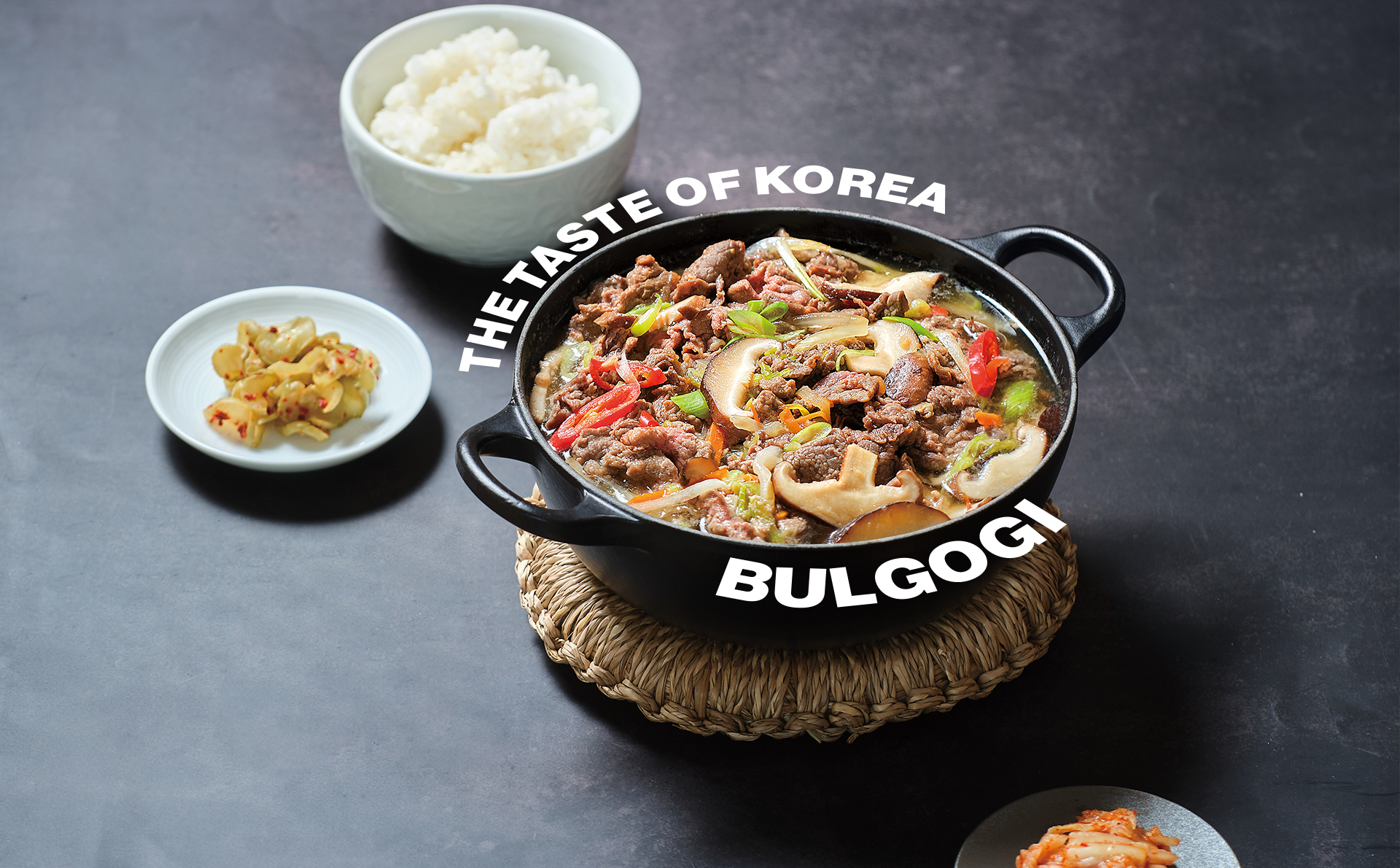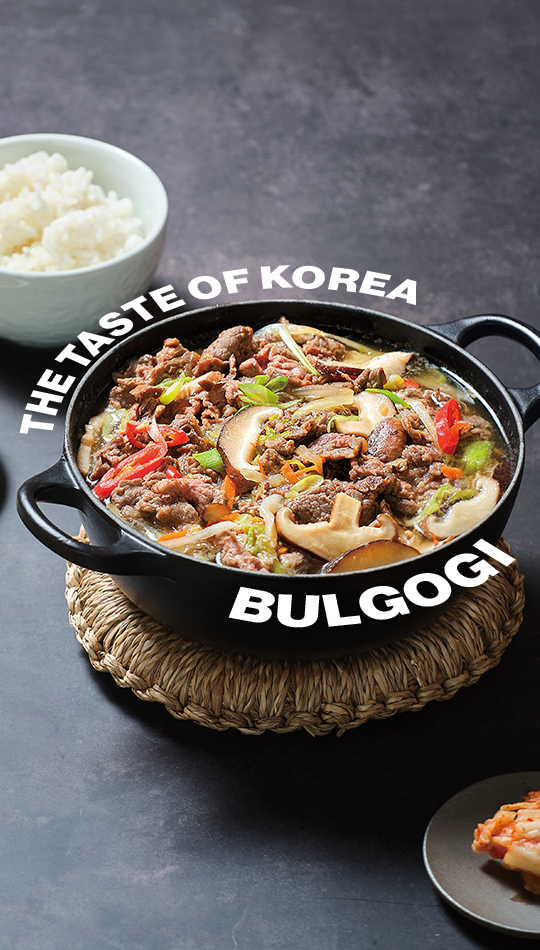Bulgogi―known as Korean BBQ beef―is a delectable dish featuring thinly sliced beef marinated in ganjang (soy sauce), sugar and sesame oil. The tender meat dish with a savory and sweet flavor has long been cherished by Koreans, and it now graces tables worldwide after continuous evolution.


Writer. Jang Heejoo
A Dish Reflecting the Times
Food carries a historical narrative. Bulgogi, a quintessential Korean dish consisting of thinly sliced beef marinated in ganjang, is no exception. Despite regional differences in preparation―whether fully grilled or gently simmered―they all share the commonality of utilizing beef and a ganjang -based seasoning.
However, bulgogi was originally a compound word of bul (fire) and gogi (meat), referring to any type of meat cooked over fire―regardless of whether it was chicken or pork. It wasn’t until approximately the 1960s that the term bulgogi began to specifically denote thinly sliced meat marinated in ganjang and grilled, as it is recognized today.
How did the seasoning―the essence of bulgogi―evolve into its present form? During the Joseon Dynasty, cattle served primarily as working animals, yielding tough, gamy meat as they weren’t raised for consumption. To mask this, people marinated the meat in ganjang , garlic, sesame oil and other ingredients before consumption. The modern bulgogi seasoning, emerging in the late 19th century amid a period of active assimilation of foreign influences, saw the addition of sugar to the traditional ganjang marinade, as it became more readily imported.
Let’s also explore why the meat in bulgogi became thinly sliced―beef was initially an inaccessible ingredient for the common populace, but with the advent of industrialization in the 1960s, there was a sharp increase in demand for beef-based dishes like bulgogi. However, the availability of tender cuts was limited. Faced with the challenge of acquiring cuts like sirloin or tenderloin, common people opted for cuts like brisket, traditionally not used for grilling, which were then thinly sliced to ensure tenderness. This led to the emergence of the concept of “meat for bulgogi” in Korea.
Diverse, Easy and Tasty
Bulgogi―stemming from such origins―has been relished across the nation in various forms. For instance, in Eonyang-eup, Ulsan, premium beef is marinated and then fully grilled until no remaining moisture, creating a slightly clustered appearance. Conversely, in Gwangyang, Jeollanam-do Province, thinly sliced beef is marinated prior to grilling, yielding thicker meat pieces, each separated from the others. In Seoul, bulgogi is prepared in a shallow pot with a raised center―known as jeongol (Korean hot pot)―where the meat is placed. As juices accumulate around the pot’s edge, broth, glass noodles and an assortment of vegetables are added, offering a delightful culinary experience.
In its diverse cooking methods, bulgogi presents the joy of selecting and savoring it in one’s preferred style. Its unique sweet flavor not only appeals to people of all ages and genders but also serves as an excellent introduction to Korean cuisine for those unacquainted with it. Furthermore, as it doesn’t rely on particularly overpowering ingredients, bulgogi complements a variety of staple foods such as rice, pasta and bread. In Korea, bulgogi has already been incorporated into a plethora of dishes―including burgers, pizzas, sandwiches, fried rice and burritos―demonstrating its versatility and adaptability in culinary innovation.
Never experienced Korean cuisine? Or perhaps interested but unsure where to start? If so, you will have to give bulgogi a try. When purchasing meat for bulgogi at your local grocery store, you can pick up cuts such as ribeye, chuck, brisket, or top round, and ensure to ask the butcher to slice it as thin as possible. Alternatively, you can opt for beef labeled specifically for carpaccio. In the absence of traditional condiments like ganjang or sesame oil, readily available bulgogi sauce can serve as a suitable alternative. If the above options seem time-consuming, consider the convenience of frozen bulgogi, offering flexibility in ingredient selection. A meal enriched with the sweet and tender flavors of bulgogi is guaranteed to make your day.
Bulgogi Rice Bowl
15 mins.
INGREDIENTS
250 g thinly sliced beef, 1/3 onion, 1 golden oak mushroom, 1/2 green onion, 1/4 carrot, 1 red chili pepper (optional), sesame seeds, 2 tablespoons ganjang (soy sauce), 2 tablespoons sugar, 1/2 tablespoon cooking wine or rice cooking wine, 1/2 tablespoon sesame oil, 1/2 tablespoon minced garlic, ground black pepper, 2 tablespoons cooking oil, 1 serving steamed rice
- Pat the beef dry with a kitchen towel to remove any excess blood.
- Marinate the beef with ganjang , sugar, cooking wine, sesame oil, minced garlic and ground black pepper, then let it sit for 30 minutes.
- Slice the onion, golden oak mushroom, green onion, red chili pepper and carrot, then heat the cooking oil in a skillet and stir-fry. Add the marinated beef and stir-fry together until cooked through to make bulgogi.
- Add a serving of steamed rice in a bowl, top it with the cooked bulgogi, and garnish with sesame seeds.
Bulgogi Sandwich
15 mins.
INGREDIENTS
250 g thinly sliced beef, 2 tablespoons ganjang (soy sauce), 2 tablespoons sugar, 1/2 tablespoon cooking wine or rice cooking wine, 1/2 tablespoon sesame oil, 1/2 tablespoon minced garlic, ground black pepper, sesame seeds (optional), 2 tablespoons mayonnaise, 1/2 tablespoon whole grain mustard, leafy green vegetables (lettuce, etc.), cheese, 1/2 tomato, 2 or more slices of sandwich bread
- Pat the beef dry with a kitchen towel to remove excess blood. Then, add ganjang , sugar, cooking wine, sesame oil, minced garlic and sesame seeds (optional), and let them sit to marinate.
- Grill the marinated meat in the pan without cooking oil until cooked.
- Spread the mayonnaise and whole grain mustard on both slices of sandwich bread.
- Place leafy greens on one slice of the sandwich bread, top it with bulgogi, cheese and sliced tomatoes, then cover it with the other slice of sandwich bread.
